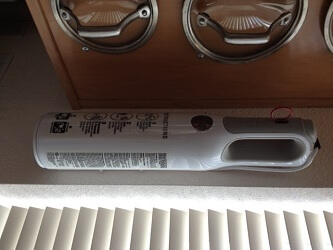Consider these three types of fires:
- Structure fires
- Vehicle fires
- Outside fires
Quiz: What’s the most frequent type of fire? Which type is increasing the fastest? Which kills the most civilians?
Answer: From a report cited on the National Fire Protection Association, outside and wildfires are increasing five times faster than other fires! But the most people die in structure fires – some 2,640 in 2011. One structure fire is reported every 65 seconds.
You probably have fire extinguishers at work. What about at home?

Unobtrusive and handy
Fire in the kitchen!
Last year, at our daughter’s house, we had the occasion to use an extinguisher just like the white one shown here. (This one is in our kitchen; our daughter’s extinguisher was in her pantry.) For some unknown reason, food in the toaster oven caught fire and started smoking. In the excitement, she opened the door – and flames burst out and up, licking against the bottom of the cupboards.
Joe shoved her aside, grabbed the fire extinguisher, pulled the safety pin (had to try twice), and doused everything. What a cloud of white! But while the toaster oven ended up a pathetic shriveled piece of blackened metal, the counter, cupboards and the rest of us were fine with just a little dusting.
The right extinguisher?
Did we check in advance to be sure we were using the right extinguisher? No! But she had the designer model, and it turns out that the typical kitchen model is a BC extinguisher. That is, it is designed to put out fires that may be caused by
- Burning liquids, oil or grease
- Electrical equipment, wiring, appliances
On the other hand, the all-purpose model for the garage is an ABC extinguisher. It is designed to handle:
- Ordinary combustibles like paper, wood and plastics
- Burning liquids, oil or grease
- Electrical equipment, wiring, appliances
Properly charged?
Check the pressure gauge on a regular basis! The arrow needs to be pointing to the green area. In our experience, some extinguishers hold their charge for years, and others lose it more rapidly. It’s like batteries . . .
Conveniently mounted?
It only takes a moment for a fire to catch hold. It’s that moment when you have the chance to act. Mount your extinguisher where it is visible and so you’ll know it is there when you need it. Tucking a loose extinguisher behind the door or in a cupboard will delay your response in an emergency.
The right size?
Small extinguishers may be appropriate for an automobile, but we recommend the larger 3 lb. size for household use. The cost for a good extinguisher starts at about $30 and can go up from there.
Tell us YOUR story about how you have used an extinguisher! The more stories we get and share about how extinguishers have saved property and lives, the more people get out there and get one! Just leave a comment in the reply box!
Don't miss a single Advisory.
Thank you for subscribing.
Something went wrong.

